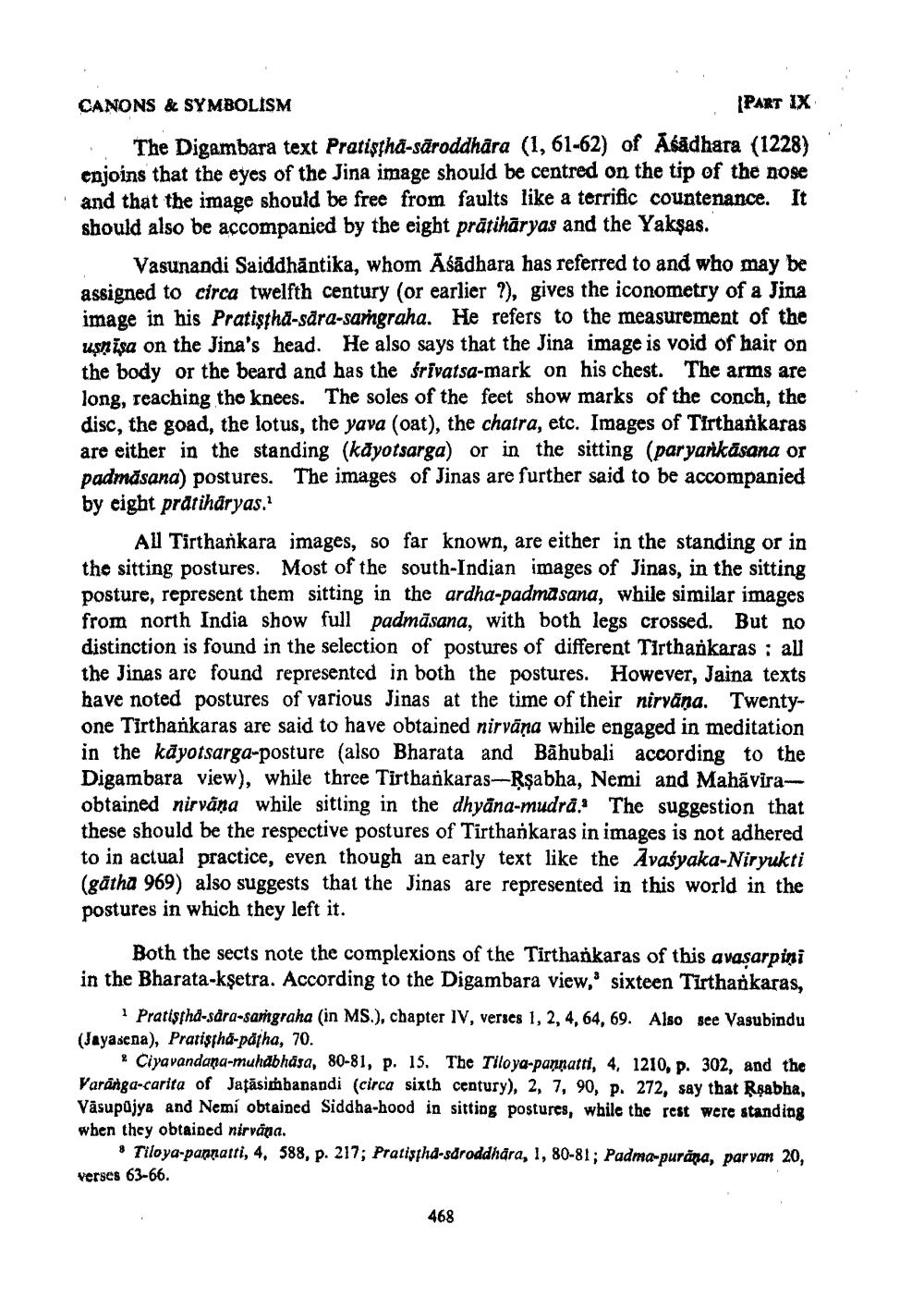________________
CANONS & SYMBOLISM
(PART IX The Digambara text Pratisha-säroddhāra (1, 61-62) of Ašādhara (1228) enjoins that the eyes of the Jina image should be centred on the tip of the nose and that the image should be free from faults like a terrific countenance. It should also be accompanied by the eight prätihāryas and the Yaksas.
Vasunandi Saiddhāntika, whom Āsādhara has referred to and who may be assigned to circa twelfth century (or earlier ?), gives the iconometry of a Jina image in his Pratiştha-sära-sarngraha. He refers to the measurement of the uşnişa on the Jina's head. He also says that the Jina image is void of hair on the body or the beard and has the śrivatsa-mark on his chest. The arms are long, reaching the knees. The soles of the feet show marks of the conch, the disc, the goad, the lotus, the yava (oat), the chatra, etc. Images of Tirthankaras are either in the standing (kāyotsarga) or in the sitting (paryarikāsana or padmasana) postures. The images of Jinas are further said to be accompanied by cight prātiharyas.?
Al Tirthankara images, so far known, are either in the standing or in the sitting postures. Most of the south-Indian images of Jinas, in the sitting posture, represent them sitting in the ardha-padmasana, while similar images from north India show full padmāsana, with both legs crossed. But no distinction is found in the selection of postures of different Tirthankaras : all the Jinas are found represented in both the postures. However, Jaina texts have noted postures of various Jinas at the time of their nirvāna. Twentyone Tirthankaras are said to have obtained nirvana while engaged in meditation in the kāyotsarga-posture (also Bharata and Bahubali according to the Digambara view), while three Tirthankaras-Rşabha, Nemi and Mahaviraobtained nirvāṇa while sitting in the dhyāna-mudra. The suggestion that these should be the respective postures of Tirthankaras in images is not adhered to in actual practice, even though an early text like the Avašyaka-Niryukti (gätha 969) also suggests that the Jinas are represented in this world in the postures in which they left it.
Both the sects note the complexions of the Tirthankaras of this avasarpini in the Bharata-kşetra. According to the Digambara view,' sixteen Tirthankaras,
Pratisha-sära-sangraha (in MS.), chapter IV, verses 1, 2, 4, 64, 69. Also see Vasubindu (Jayasena), Pratisha-patha, 70.
Ciyavandana-muhabhäsa, 80-81, p. 15. The Tiloya-pannatti, 4, 1210, p. 302, and the Varanga-carita of Jaţăsimhanandi (circa sixth century), 2, 7, 90, p. 272, say that Rşabba, Vasupujya and Nemi obtained Siddha-hood in sitting postures, while the rest were standing when they obtained nirvana.
Tiloya-pannatti, 4, 588, p. 217; Pratishd-sdroddhára, 1, 80-81; Padma-purăra, parvan 20, verses 63-66.
468




